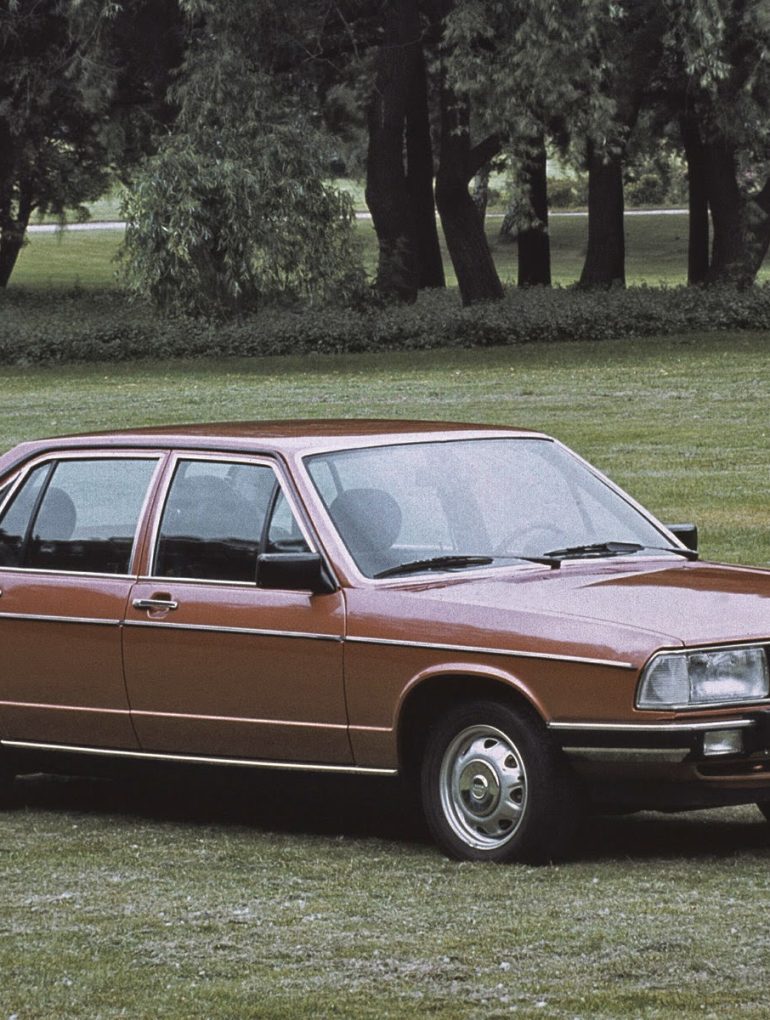After the success of Audi’s first large post- war saloon there was no question of there being a successor. Codenamed C2, the new 100 was bigger than the old, more refined and better-equipped.
It had larger engines too, the star of the range being a new five-cylinder 136bhp 2144cc unit – the world’s first petrol five- cylinder – that did much to give the car a distinct character with its appealing warble. It also gave a 120mph top speed.
The possibility of the US market mandating a 40mph frontal impact test produced a particularly effective front crash structure for relatively little extra weight compared with the old car.
The new 100’s styling was crisp, more a development of the design language established with the 1972 Audi 80 than the original 100. Its clean-cut, modern looks advanced Audi’s thrust into the executive territory occupied by Mercedes and, increasingly, BMW. Six-light glazing and impact-absorbing bumpers added to the contemporary look, which continued inside with a clean-sculpted appearance to the dash and door casings.
Details
The first Audi 100, developed by Volkswagen’s subsidiary Auto Union at Ingolstadt, was shown to the press on 26 November 1968. Its name originally denoting a power output of 100 PS (74 kW; 99 hp), the Audi 100 was the company’s largest car since the revival of the Audi brand by Volkswagen in 1965. The C1 platform spawned several variants: the Audi 100 two- and four-door saloons, and the Audi 100 Coupé S, a stylish fastback coupé, which bore a remarkable resemblance to the Aston Martin DBS released a year earlier, especially at the rear end, including details such as the louvres behind the rear side windows and shape of the rear light clusters.
Audi followed up the introduction of the four-door saloon in November 1968 with a two-door saloon in October 1969 and the 100 Coupé S in autumn 1970. The cars’ four-cylinder engines originally came in base 100 ( 80 PS or 59 kW; 79 hp), 100 S (1.8 litre, 90 PS or 66 kW; 89 hp) and 100 LS (1.8 litre, 100 PS or 74 kW; 99 hp) guise, while the Coupé was driven by a bored-out 1.9 litre developing 115 PS (85 kW; 113 hp). From April 1970 the 100 LS could be ordered with a three-speed automatic transmission sourced from Volkswagen.
The Audi 100 enjoyed a level of commercial success for which the company had not planned. As a distinguished German commentator pointed out, the rough engine note was unlikely to discourage buyers whose first car had been a Volkswagen and who aspired to drive a diesel powered (pre-turbo) Mercedes-Benz.
Despite running the Ingolstadt production line at full capacity, supply fell short of demand to such an extent that during the summer of 1970 an additional production line for Audi 100s was set up in Volkswagen’s own Wolfsburg plant, which made it the first water-cooled car to be produced in Germany’s (and by some criteria the world’s) largest car plant.
Starting with model year 1972 the 80 and 90 PS versions were replaced by a new regular-petrol-variant of the 1.8 litre engine developing 85 PS (84 hp/63 kW); at the same time, the 100 GL was introduced that featured the 1.9 liter engine formerly used in the Coupé S only.
In March 1971 the 500,000th Audi was produced. By now the Audi 100 had become the most commercially successful model in the company’s history, so it is unsurprising that the car in question was an Audi 100 produced at the Ingolstadt plant.
In September 1973 the 100 received a minor facelift with a somewhat smaller grille and reshuffled taillight lens patterns. The rear torsion bar was replaced by coil springs. For model year 1975 the base 100 was re-christened the 100 L and received a 1.6 litre four-cylinder engine (coming out of the Audi 80). A four-wheel drive prototype of the Audi 100 C1 was built in 1976, long before the appearance of the quattro.
In the United States the Audi 100 appeared in 1970 in LS guise, with a 115 hp (86 kW) SAE 1.8 liter engine and with either two or four doors.[7] For 1972 the engine was enlarged to 1.9 litres, but since the power figures were now in SAE net claimed power was down to a less impressive sounding 91 hp (68 kW). A base and a GL model were added, as was an automatic transmission. For 1974 the lineup was again restricted to the 100 LS, while the larger safety bumpers were now fitted. Power increased to 95 hp (71 kW) for 1975, courtesy of fuel injection. Standard equipment was also improved, but at the cost of a sizable price hike. In August 1977 the new Audi 5000 replaced the 100, although another 537 leftover cars were sold in 1978. The Coupé was never sold in the United States.
Audi 100 Avant
Big hatchbacks were a rarity in the 1970s, and the Avant was one of a handful of executive class five-door models, joining the smaller Audi 50 as one of two hatchbacks in Audi’s mid-1970s range.
| Audi 100 (C1) |
| Overview |
| Production |
1968-1976
827.474 built
Saloon: 796,787
Coupé S: 30.687 |
| Assembly |
Neckarsulm, Baden-Württemberg, Germany
Ingolstadt, Bavaria, Germany
Wolfsburg, Lower Saxony, Germany |
| Designer |
Ludwig Kraus |
| Body and chassis |
| Body style |
2-/4-door saloon/sedan
2-door coupé |
| Layout |
FF layout |
| Platform |
Volkswagen Group C1 platform |
| Powertrain |
| Engine |
1.8 L I4
1.9 L I4 |
| Transmission |
4-speed manual all-synchromesh
automatic optional |
| Dimensions |
| Wheelbase |
2,675 mm (105.3 in) (coupe) |
| Length |
4,399 mm (173.2 in) |
| Width |
1,727 mm (68 in) |
| Height |
1,417 mm (55.8 in) |




